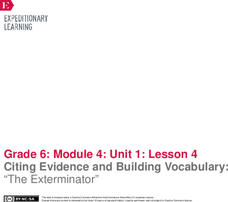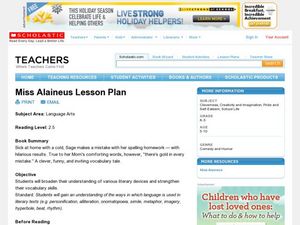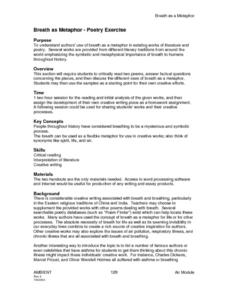EngageNY
Mid-Unit Assessment: Analyzing a New Narrative about a Natural Disaster, Part II
See it through my eyes. Scholars complete mid-unit assessment part II by writing an essay describing how the narrator's point of view influences how the story is told in the text In the Middle of the Storm. Pupils also complete a...
EngageNY
End of Unit 2 Assessment: Final Literary Analysis
Get ready to review and revise! Scholars peer edit each other's literary analysis essay drafts. Next, using peer and teacher feedback, pupils compose their final drafts.
EngageNY
Summarizing Complex Ideas: Comparing the Original UDHR and the "Plain Language" Version
The eighth lesson plan in this series continues the focus on vocabulary and increasing young readers' awareness of academic language. Pairs of learners participate in a short vocabulary review activity called Interactive Words in which...
Curated OER
Book: Super Power: Americans Today
Students, after reading Chapter 1 in the book, "Super Power: Americans Today," analyze the recognition of the quote, "Hunger does not breed reform; it breeds madness and all the ugly distempers that make an ordered life impossible," by...
EngageNY
Understanding Themes in Esperanza Rising
Determining a theme or central idea is greatly emphasized in the Common Core standards. Target that skill though big metaphors and central symbols in Pam Muñoz Ryan's Esperanza Rising. Help your class reach the standard through...
EngageNY
Deepening Your Research
Give credit where credit is deserved. Scholars discuss what makes a credible source as they take a look at "An Apparel Factory Defies Sweatshop Label, but Can It Thrive?" Learners read the article to look for answers to the research...
EngageNY
Reading for Gist: “Middle Ages” Excerpt 2
Read and repeat. Scholars repeat the strategies for digging deeper into text from instructional activity two. This time they focus on Middle Ages Excerpt 2. Learners write unfamiliar words in the word catcher and use details from the...
EngageNY
Citing Evidence and Building Vocabulary: “The Exterminator”
It is an out-of-body experience. Scholars take a look at the sidebars outside the body of the text in The Exterminator. They discuss the purpose of this type of text feature and work to determine the gist. Learners write unfamiliar...
EngageNY
Structuring The Search: Categorizing Our Research
What can you contribute? Scholars read text to determine how ants contribute to the rainforest. First, they categorize and sort facts gathered from reading. Next, readers focus on specific terms in each paragraphs of the text Ants by...
EngageNY
Geometric Sequences and Exponential Growth and Decay
Connect geometric sequences to exponential functions. The 26th installment of a 35-part module has scholars model situations using geometric sequences. Writing recursive and explicit formulas allow scholars to solve problems in context.
Curated OER
Math Fraction Hunt
What a fun way to practice fractions! Your class engages in a fraction hunt in which they use words to find clues to a treasure hidden in the classroom. The treasure, in this case is a Mars bar. However, it could be anything, including a...
Cherokee County Schools
Simple Machines Project
The choice is simple: create a PowerPoint presentation, write a book, or invent a compound machine. Whichever project your young scientists choose, they will be engaged in creatively demonstrating their knowledge of simple...
K12 Reader
Add a Prepositional Phrase to an Adjective Phrase
Don't just rely on adjectives to describe the nouns in your sentence! Use a handy worksheet to review prepositional and adjective phrases. Learners read eight sentences and add prepositional phrases as adjectives after either the subject...
Curated OER
Personal Collecting
Pupils attempt to form a collection of actual objects or research from a variety of sources. They write a formal proposal for the contents of the collection before beginning.
Curated OER
My Name Is Me!
Students write about themselves. In this personal writing lesson, students write their name vertically down a sheet of paper and think of a self descriptive word that matches each letter of their name. Students write a descriptive...
Curated OER
Picture Writing
Fourth graders create symbols. In this visual arts lesson, 4th graders study cave drawings, Native American pictographs, and Aboriginal Drawings prior to creating their own communication without using words.
Curated OER
Short Story Framework
The class gets creative after listening to a short story containing a definitive structure. They are required to think about character, relationship, and setting, while attempting to show rather than tell, in their writing. Dialogue,...
Novelinks
The Tempest: A-Z Book Project
Create a picture dictionary for one of William Shakespeare's most famous plays. After readers finish The Tempest, they assign each letter of the alphabet to a concept or character, and add a description and evidence from...
Curated OER
Telling Stories: Symbols of a Life
Art and literature can go hand in hand, they both are used to express elements of the self in a creative and interesting way. Budding story tellers interpret and analyze the narrative elements they find in a work of art. They focus on...
Curated OER
Module 7--Socializing
In this socializing worksheet, learners write a response to seven statements that people might say, think of a creative way to reply to seven sentences and write a sentence for one social custom from eight various countries.
Curated OER
Witness to a Brawl
Using The Musicians' Brawl, middle schoolers first impressions and the effect the title has on a piece of work. Then they analyze the narrative elements to art and write a newspaper article for the painting. In this narrative art...
Curated OER
The Lion, the Witch, and the Wardrobe: Vocab Squares
Creatively develop and reinforce new vocabulary from the book, The Lion, the Witch, and the Wardrobe by C.S. Lewis, using these vocabulary squares. Each square is divided into four quadrants asking scholars to input the word, a...
Curated OER
Miss Alaineus Lesson Plan
Students gain an understanding of various literary devices and strengthen their vocabulary. In this Miss Alaineus lesson plan, students read the vocabulary tale, discuss the use of literary devices and choose from 4 possible culminating...
Curated OER
Breath as Metaphor - Poetry Exercise
Students are required to critically read two poems, answer factual questions concerning the pieces, and then discuss the different uses of breath as a metaphor. They use the samples as a starting point for their own creative efforts.

























